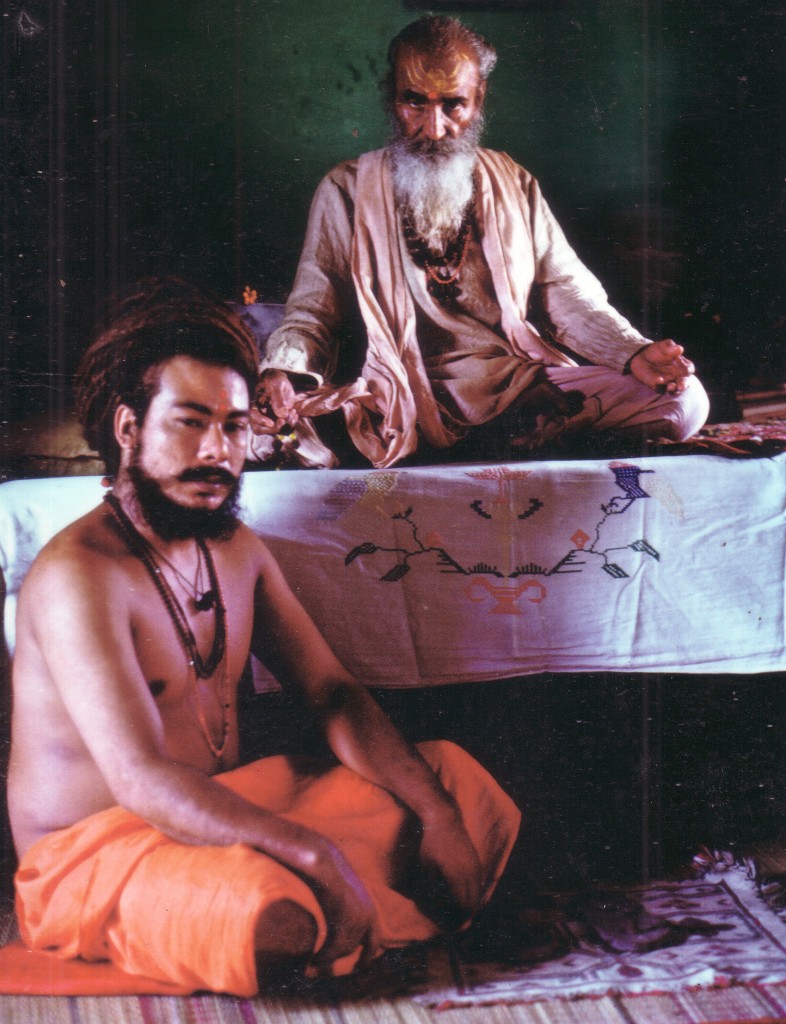
Guru Purnima Full Moon – Guru Puja – July 31, 2015

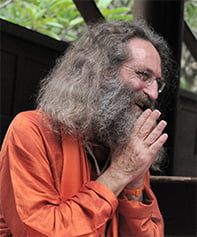
The Blessings and Gratitude Moon
“I send you love, light and the blessings of health, happiness, and prosperity on the occasion of Guru Purnima, from India.” – Baba Rampuri
OM NAMO NARAYANAYA!
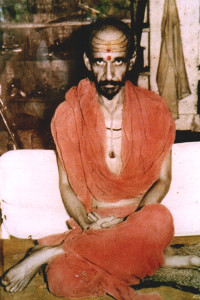
For those of us in Wisdom Traditions in India, especially the Oral Tradition, this is our most important full moon of the year.
Today, during this full moon, we in the traditions of India, express our gratitude for, honor, and worship the Guru. In my guru puja today I name not only my formal gurus in my tradition and lineage, and our Devata Gurus such as Shri Adi Shankaracharya Maharaj and Guru Dattatreya, but all my many gurus, teachers, and mentors, for all time.
The guru is more than only his/her body, as we may think of the Mother Ganga as more than merely H2O, for the guru is that thing in Nature which allows us to be connected with Her totality, that which allows us to enter deeper in our engagement with the world, and as the Initiator into its great mysteries.
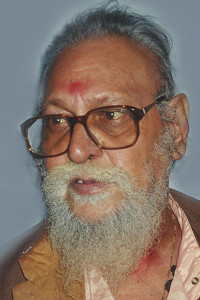
In our own life-story as in any Storytelling, the archetype of the Guru, who Joseph Campbell calls the “mentor” is the crucial element in the story paradigm that guides our hero into and across the Extraordinary World where challenges appear, and ultimately supports our hero in confrontation with his/her nemesis.
The covenant between Consciousness, personified as Shiva, and man (as he may perceive the world), provides a Way Home, a Path of Knowledge, in the form of discipleship and continuous lineage. We call this the “Guru-Shishya Parampara,” the Oral Tradition.
As the Moon reflects the light of the Sun, the Guru reflects the light of Knowledge. So, imagine, when the Moon is full, it illuminates things that are normally hidden by the darkness of night, as the Guru may illuminate things normally hidden by the darkness of ignorance. When the Moon is at full intensity, so is Guru.
The Full Moon on the 31st of July, ending the Indian month of Ashadh, begins a traditional four-month period when sadhus, yogis, and gurus stay out of the rains, usually in one place,
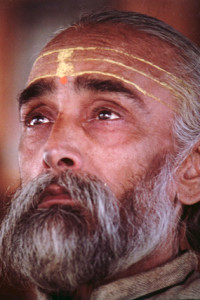
and keep travel down to a minimum. It’s the first day of the “Guru’s Retreat.”
This is a day when all the disciples and devotees gather around their gurus, for the blessings are most powerful on this day, celebrate the full connection of Sun and Moon and Guru and Disciple. They honor the guru and make puja to him or her. Disciples and devotees bring gifts of new cloth, flowers, sweets, and dakshina.
And for those disciples and devotees that cannot be physically with the guru, one can connect with the guru through the full moon. We bounce messages and blessings off the moon, and the connection on Friday, July 31st is at its greatest clarity and power.
We think of this Full Moon as the Blessings and Gratitude Moon. So this is the most opportune moment for us to honor ALL our teachers, whether alive or otherwise, whether human or otherwise, and show our gratitude for their blessings which grace our lives.
In our post modern times, when the Ocean of Story is so horribly polluted by the political and commercial

narratives, when our Speech has been colonized by the euphemisms of mass media, let us use the word “guru” as a metaphor to signify those who will connect us with our organic selves, giving knowledge and understanding not invented for the marketplace, but passed from human generation to human generation, whether in India, Europe, or anywhere else. He/She who will dispose of the illusion of separateness, challenge the myth of the individual, and pull us from our isolation into the human collective within which we may be prosperous.
Monsoon rains are pouring down now in India. I haven’t checked reports, but it seems to be a good one, lots of rain, at least where I’ve been. Traditionally, we sadhus and yogis travel from place to place during much of the year. We go on pilgrimage, visit our elders and gurus, we are invited to feasts and functions, we attend gatherings. But monsoon has never been the best time to do this, especially in the “old days” when our travel was by foot.
In our tradition, in which metaphor and body are indistinguishable, the guru is the matrix of all things, mother and father at the same time, the source code. That’s why we sing:
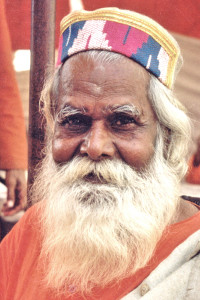
Gurur Brahmaa Gurur Vishnu
Gurur Devo Maheshwarah
Guru Saakshaata Parabrahma
Tasmai Shri Guruve Namah
Guru is Brahma, Guru is Vishnu,
Guru is Maheshwara (Shiva),
Guru is Supreme Brahman Itself
Prostration unto that Guru
The Word “Guru” in an Indian Wisdom Tradition
 In these times, when words can mean anything you want them to mean, the word, “guru,” is used in countless different ways. So, I’m not interested in arguing for a “true” meaning for the word, but wish to comment on its meaning within my Wisdom Tradition, that of Indian Naga Babas.
In these times, when words can mean anything you want them to mean, the word, “guru,” is used in countless different ways. So, I’m not interested in arguing for a “true” meaning for the word, but wish to comment on its meaning within my Wisdom Tradition, that of Indian Naga Babas.
As analogy, guru is to the intellectual/spiritual gene what mother/father is to the DNA. The name and the blood that is transmitted by one’s biological parents is reflected by the name and tradition transmitted by the guru. That name is significant and “fixes” the individual in a biological family or in a spiritual lineage. As family in the biological sense is very real and goes way back to that original woman in Africa (so they say), a spiritual tradition must also be as real, going way back to the provider of that ancient spiritual gene. It is neither ideology nor beliefs that are transmitted by a tradition, but a way of knowing and Speech that is supported by a vast compendia of oral storytelling.
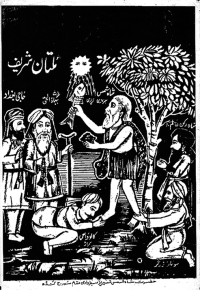
As an archetype, the guru is much more than the Mentor. First and foremost he is Door Guardian, Dwarpal, Darvish, the Sphinx. The Bouncer. One must get past him in order to enter the Extraordinary World. Entry is not guaranteed and there may be tests, ordeals, and riddles for the disciple, our “Hero,” to endure, while attempting to enter the new world. This Door Guardian stands on the edge of worlds, where they meet on the cusp of things, like a hinge between the ordinary and the extraordinary, between the sacred and the profane, between the Macrocosm and the Microcosm. Once the Hero gets past the Door Guardian, his credentials are established for entering the Extraordinary World, and this threatening Door Guardian becomes his protector.
In the world of a Wisdom Tradition, the Guru tests the disciple, and if found suitable (and that can mean many different things), not only opens the door of the lineage and the tradition, but serves as the patron of the disciple as well. He gives the disciple his name as do our parents – two names in fact, a first or familiar name, and a family name. The disciple inherits the name of his guru, and receives a certain amount of entre within the greater tradition based on that name. Of course, he must strive to keep that name honorable.

In the traditional world there are no weekend courses, in fact, there are no courses at all, unless you want to consider your whole life as the course. Books and texts may be valuable, inspirational, and wonderful, but lack the authority of a voice, or a harmony of voices echoing within the lineage. In the tradition we are more interested in actors than their agents and representatives.
The means of obtaining knowledge in a tradition is very different from the means used by a student in the university, and more similar to the Sorcerer’s Apprentice. Not by attending lectures, workshops, and study of texts, but it is by serving the guru and the family, i.e., the lineage, that one comes in contact and absorbs the knowledge and authority of the tradition itself. The disciple begins to see his body as a limb of the lineage. A frequent line in Tantric texts is, “The pleased guru says….” This implies that one must please the guru, which distinguishes “guru seva,” which means apprenticeship, from “(nishkam) karma yoga,” which is service without attachment to the results. Guru seva requires a result, which is that the guru becomes pleased.
By service, which is the nature of apprenticeship, one slowly absorbs the tradition until one becomes part of that tradition and obtains the authority to pass it on.
The cost of this discipleship is considerably higher than the most expensive weekend retreat or a 6 week yoga teacher training. One pays for this with one’s life, as we say in the tradition, with one’s “man, dhan, tan,” body, mind, and resources.
The goal of the guru is NOT to make disciples, but to make gurus. Most gurus in traditions will tell you that disciples are nothing but trouble, in the same tone of a frustrated parent with a naughty child. Disciples don’t pass on the tradition, they must become gurus first.
In the Oral Tradition, the guru is not the teacher, there are MANY teachers. The guru provides this access as the patron of the disciple. The guru is not a psychiatrist, but more the parent with an agenda for the child, sometimes comforting, other times scolding. The guru is not an example, but a guide. “Do as I say, not as I do,” is an expression used in countless guru stories, and an expression I have heard many times during my own discipleship.

Besides being the Door Guardian and the Mentor, the guru is also the Shape Shifter, a mercurial being capable of great change, appearing in different ways to the disciple, causing the disciple confusion as to who this person really is. What is written in a book doesn’t change. The words remain fixed and frozen from the time ink goes on the page. But the guru is dealing with a particular context that is always in a state of flux, as is the world. So his words will change to meet the context of the moment. This is what keeps a tradition dynamic and relevant.
What I have written above is a very specific application of the word, “guru,” and not meant as an ideal that we should aspire to. But we should know that this is how we think of guru in an “exotic” oral tradition. When we think about what a guru means to us, today, it’s helpful to know where the word is really coming from.
Guru Purnima is a day in which we honor all teachers.
May you be healthy, happy, prosperous, and wise!
[divider style=”shadow” margin_top=”05px” margin_bottom=”20px”]
